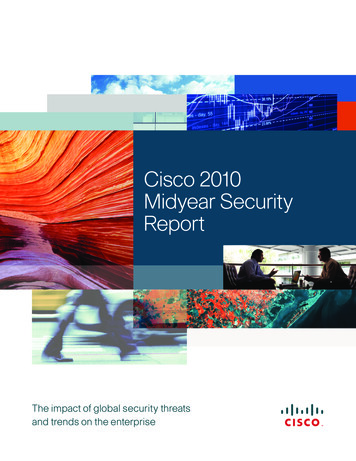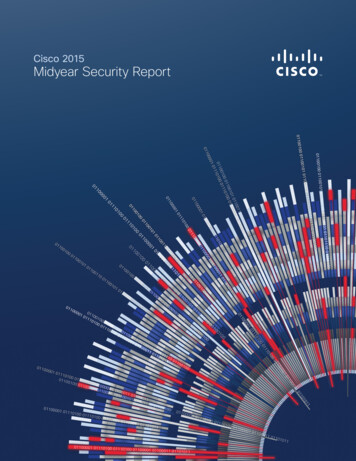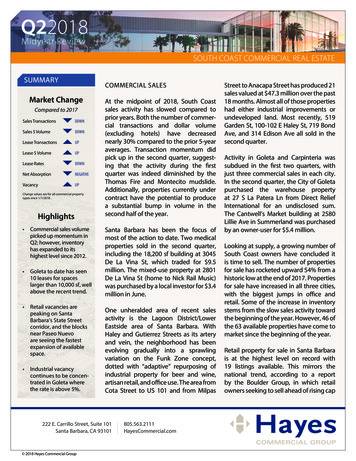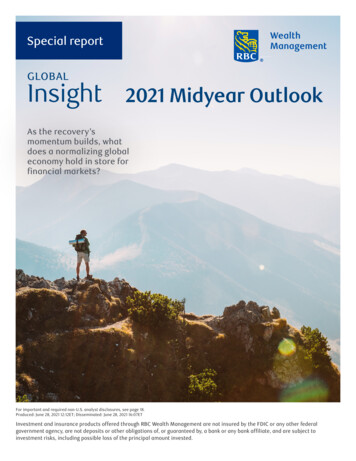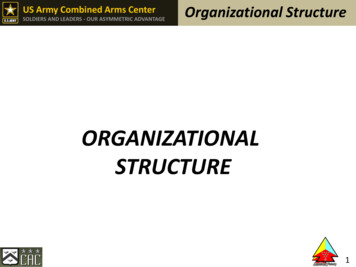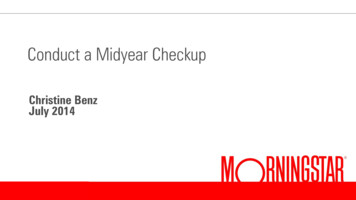
Transcription
Conduct a Midyear CheckupChristine BenzJuly 2014
Best Practices for Portfolio Checkups Infrequent: Annual, semi-annual, or quarterly at the mostTargeted: Employ a checklist to help you get in and outFundamentally driven, not just focused on performanceProgress from most important to less important variablesTake tax and transaction costs into account if changes are needed
6 Steps in the Portfolio-Checkup Process Step 1: Gauge viability of current planStep 2: Evaluate portfolio positioningStep 3: Check liquid reservesStep 4: Review individual holdingsStep 5: Troubleshoot current risk factorsStep 6: Conduct a cost audit
Step 1: Gauge Viability of Current Plan (Accumulators) Thumbnail test: 15% current salary annual savings targetFidelity benchmarks: Save 1X current salary by age 35 Save 3X current salary by age 45 Save 5X current salary by age 55401(k) contribution limits, 2014: 17,500 ( 23,000 50 )IRA contribution limits, 2014: 5,500 ( 6,500 50 )
Step 1: Gauge Viability of Current Plan (Accumulators) Use an online calculator to gauge adequacy of current investmentsand savings rate.Online tools include: T. Rowe Price Retirement Income Calculator Fidelity Retirement Quick Check Fidelity Retirement Income Planner
Step 1: Gauge Viability of Current Plan (Accumulators) The best tools are holistic and factor in: Inflation Reasonable return expectations, variability of returns (MonteCarlo modeling) Taxes The role of other income sources, such as pensions andSocial Security
Step 1: Gauge Viability of Current Plan (Retirees and PreRetirees)If already retired and taking withdrawals, check viability of currentwithdrawal rateThe traditional rule of thumb is that 4% with an annual inflationadjustment is a safe withdrawal rate for most For someone with an 800,000 portfolio:-- Year 1 Withdrawal: 32,000-- Year 2 Withdrawal: 32,960 (assuming 3% inflation)Recent research suggests an even more conservative withdrawal rate(3%) makes sense given low bond yields
Step 2: Evaluate Portfolio Positioning Morningstar’s X-Ray tool a good starting pointPortfolio Manager enables you to X-Ray, as does Instant X-Ray (onTools tab of Morningstar.com)
Step 2: Evaluate Portfolio Positioning
Step 2: Evaluate Portfolio Positioning Focus on asset allocation relative to your targets (MorningstarLifetime Allocation Indexes and target-date funds can be a startingpoint)Check sector/style positioningGeographic exposureIndividual stock overload
What Should You Do if You’re Light on Stocks? Stay mindful of current valuations: Average price/fair value forMorningstar’s covered stocks 1.04Employ a dollar-cost averaging strategy, deploying fixed amounts atregular intervalsMake sure you have a good value-oriented manager (or two) in yourportfolioLook to Morningstar’s highly rated stocks for ideasHold a bit of extra cash to meet opportunities as they arise
Favorite Value-Leaning Funds (Gold- or Silver-Rated) Dodge & Cox Stock (DODGX): GoldAmerican Funds American Mutual (AMRMX): GoldAmerican Funds Washington Mutual (AWSHX): GoldArtisan Value (ARTLX): SilverSound Shore (SSHFX): SilverTweedy, Browne Global Value (TBGVX): SilverVanguard Equity-Income (VEIPX): SilverVanguard Value Index (VIVAX): SilverVanguard Windsor II (VWNFX): Silver
Favorite Reasonably Priced Stocks (4-Star Plus Wide Moat,Low Uncertainty) Baxter International (BAX)Clorox (CLX)Enbridge (ENB)ExxonMobil (XOM)Philip Morris (MO)Procter & Gamble (PG)Spectra Energy Partners (SEP)Wal-Mart Stores (WMT)
What Should You Do if You’re Light on Bonds? Rebalance into bonds, but limit interest-rate sensitivity and keepcredit quality highInvest with flexible core fixed-income funds such as Dodge & CoxIncome, Metropolitan West Total ReturnIf retirement is close at hand and you’re notably underweight bonds,de-risk immediately Move bond money to cash Dollar-cost average during a period of months
Step 2: Evaluate Portfolio Positioning: Some BenchmarksTotal U.S. market stylePrice/fair value by style
Step 2: Evaluate Portfolio Positioning: Some BenchmarksGlobal market-cap distributionU.S.: 48%Rest of world: 52%Developed markets: 90.9%Developing markets: 9.1%
Step 3: Check Liquid ReservesBaseline amount if retired:6 months’ to 2 years’ worth of living expensesBaseline amount if working:3 to 6 months’ worth of living expensesDo not count:Residual cash in mutual funds, short-term bonds (manuallycalculate; don’t use X-Ray tools)
Step 4: Review Individual Holdings Morningstar Ratings and Analyst Reports enable you to quickly reviewthe status of current holdings.For funds, red flags include: Ratings, manager, strategy changes Persistent underperformance vs. cheap index fund Dramatically heavy stock, sector betsFor stocks, red flags include: High price/fair value, low star rating Negative moat trend
Step 5: Troubleshoot Potential Risk Factors Risk Factor 1: Tricky times for bond investors Risk Factor 2: Complacency about inflation Risk Factor 3: Overvaluation in small and mid-caps
Risk Factor 1: Tricky Times for Bond Investors Investors have been buying high-yield bonds: 7 billion in new flowsduring past yearBut the yield differential (or “spread”) between high-yield bonds andTreasuries is just 3.4 percentage pointsSpreads have only been this low 9% of the time since 1996Fed chair Janet Yellen: “High-yield bonds have certainly caught ourattention. There is some evidence of reach-for-yield behavior.”
High-quality bonds carry risks of their own: greater interest-ratesensitivity Consider the following “duration stress test” for your high-qualityholdings The fund’s duration minus fund’s SEC yield expected loss over oneyear period if interest rates rose by 1 percentage point Stress test most useful for high-quality bond types, less useful forjunk bonds, international bonds, etc.
Stress Test Examples Vanguard Total Bond Market IndexDuration of 5.6 years minus SEC yield of 2% 3.6% loss if ratesrose by 1 percentage pointVanguard Long-Term Bond IndexDuration of 14.2 minus SEC yield of 4.1% 10% loss if rates roseby 1 percentage point
Risk Factor 2: Complacency About Inflation Investors have been selling inflation-protected bond funds; 26 billionin outflows during the past yearMotivations included high interest-rate sensitivity, benign CPIBut even though CPI is mild, investors’ actual inflation experiencesmight be differentFood prices increased by 0.7% in May 2014; energy prices increasedby 0.9%
Risk Factor 2: Complacency About Inflation Best sources of inflation protection include the following: TIPS (Vanguard Short-Term Inflation-Protected Securities afavorite—VTIP or VTIPX) Stocks, especially wide moats with pricing power Real estate, commodities, gold Bank-loan investments
Risk Factor 3: Overvaluation Among Small and Mid-Caps Median price/fair value for all stocks in our coverage universe 1.04Median price/fair value for small- and mid-cap stocks in our coverageuniverse 1.06If peeling back on stocks as part of rebalancing program, concentratereductions here
Step 6: Conduct a Cost Audit Total portfolio cost audit: Compare your portfolio’s expense ratio (in XRay) to that of a good target-date fund for your age range.Expense ratio for T. Rowe Price Retirement 2025: 0.72%Expense ratio for Vanguard Target 2025: 0.17%
Step 6: Conduct a Cost Audit Holdings-level cost audit for index funds, ETFs.ETF price wars have been good for consumersAre your holdings as cheap as the cheapest funds available to retailinvestors in each asset class? U.S. Stock: 0.04% International Stock: 0.09% Bond: 0.05%
28
6 Steps in the Portfolio-Checkup Process Step 1: Gauge viability of current plan Step 2: Evaluate portfolio positioning Step 3: Check liquid reserves Step 4: Review individual holdings

